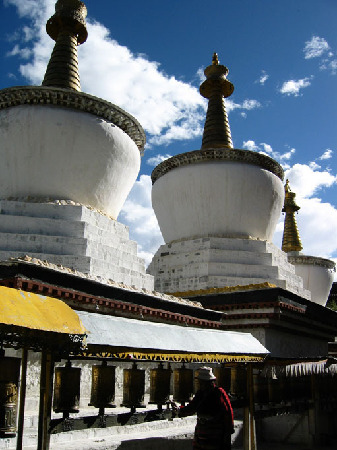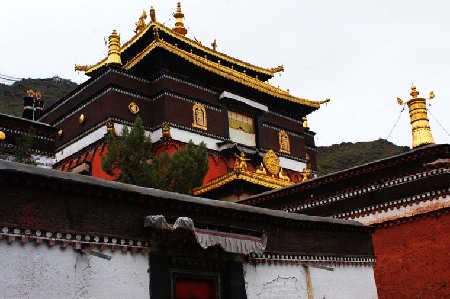| |

Inside the hall hangs a huge picture of a Qing-dynasty emperor dressed in a kasaya (loose-fitting robe) and holding a Dharma wheel. Before the picture is a tablet inscribed with "Long live Emperor Daoguang" (who reigned from 1821-1851). Whenever the emperor issued a decree, the Panchen would kowtow before the tablet to express his gratitude after receiving it. The side hall of the Han Chinese Buddhist Temple is the meeting room where the Qing grand minister resident of Tibet and the Panchen used to meet.
West of the Tashilhungpo Monastery is the Maitreya Buddha Hall, which was built in 1914 under the supervision of the 9th Panchen Qoigyi Nyima. The hall is 30 meters high and covers 862 square meters.
In the hall, the bronze statue of Maitreya Buddha is the largest of its kind in the world. The statue used 6,700 taels (268 kilograms) of gold and 115,000-odd kilograms of copper. The 26.2-meter-high statue sits on a 3.8-meter-high lotus seat. Its shoulder is 11.4 meters wide; foot, 4.2 meters long; hand, 1.6 meters wide; middle finger, 1.6 meters long; and ear, 2.8 meters long. Between his eyes are inlaid 1,400 pieces of diamond of various sizes, pearls, amber, coral, and other precious stones.
In 1985, the State Council allocated special funds to renovate the divine pagoda of the 5th to 9th Panchen Lamas, which had been destroyed. Under the personal supervision of the 10th Panchen, the sacrificial hall built to the memory of past Panchen Lamas was named Tashinamgyi (Auspicious Heaven), which opened on January 22, 1988. The whole project lasted three years and eight months.
Covering a floor space of about 2,000 square meters, the hall is 33.7 meters high, and houses the 11.52-meter-high divine pagoda. The gilded pagoda, solemnly and grandly decorated, is covered with a layer of silver and inlaid with precious stones. The remains of the Panchen Lamas in five sandalwood boxes are placed inside. In the hall's center is the bronze statue of the 9th Panchen Qoigyi Nyima, while the walls of the hall present murals depicting the contributions of famous lamas of different sects.

The 10th Panchen Erdeni Qoigyi Gyaincain passed away on an inspection tour to Xigaze on January 20, 1989. Three days later, the State Council decided to build a sacrificial hall and a stupa to enshrine the body of the 10th Panchen Lama for people to pay their respects and to memorialize his love for the country and his devotion to Tibetan Buddhism.
After the design was carefully chosen, the construction started on September 20, 1990. The state allocated 64.24 million yuan (US$7.93 million) of special funds, and 614 kilograms of gold and 275 kilograms of silver for the hall's construction. The project lasted three years.
A grand inaugural ceremony was held on September 4, 1993 and the hall was named Shesongnamgyi, meaning sacrificial hall for the three sages of Paradise, Human World, and Nether World.
On August 30, 1993, the body of the 10th Panchen Lama was moved into the stupa. The body was first put in a sandalwood bier, which was then put into a specially made safety cabinet and finally moved into the Precious Bottle in the stupa. At the entrance is a life-size statue of the 10th Panchen Lama. Around the body are a variety of religious articles, such as a kasaya, tangka painting scrolls, Buddha statues, and scriptures.
The Tashilhungpo Monastery boasts priceless Buddha statues, Buddha stupas (shrines), and tangka paintings, as well as handwritten Pattra Leaf Sutra (literature), and Gangyur written in gold power ink. In addition, it has a rich collection of porcelain, enamel, and glassware passed down from various dynasties. Frescoes in the Tashilhungpo Monastery are unique in that they feature changing shapes and bright colors, constituting another masterpiece of Tibetan Buddhist art. All these are valuable for Tibetan studies.
Best time to go: In August on the Tibetan calendar each year.
|
|
